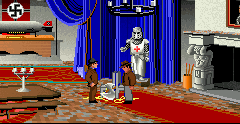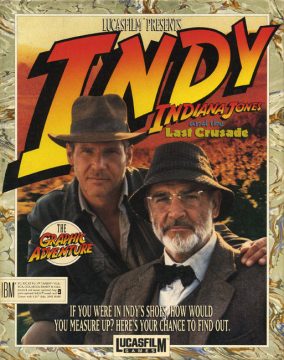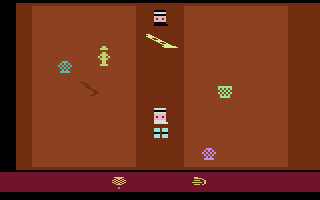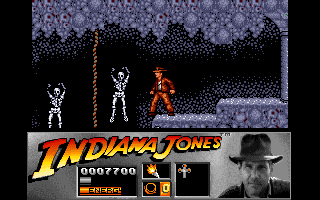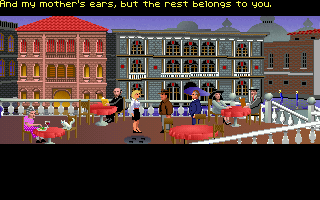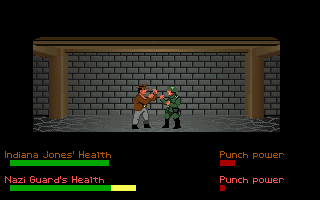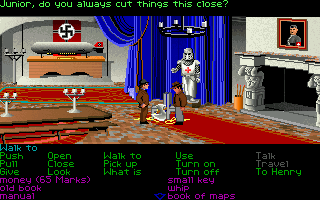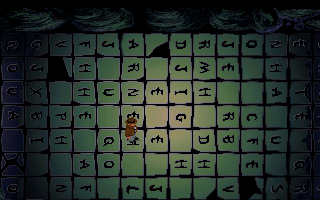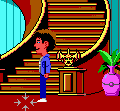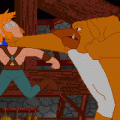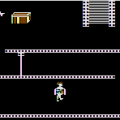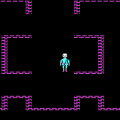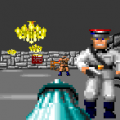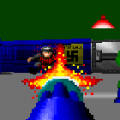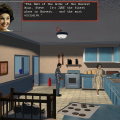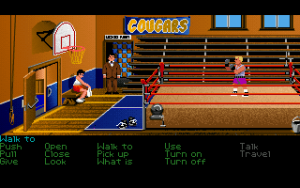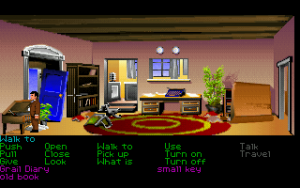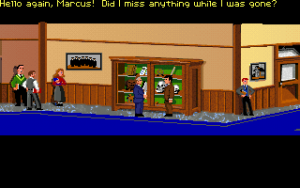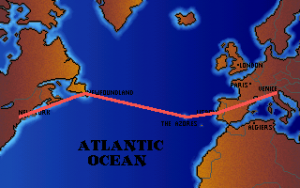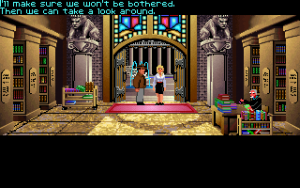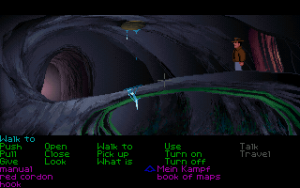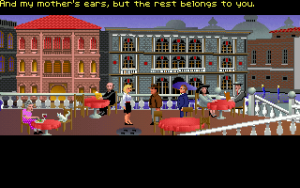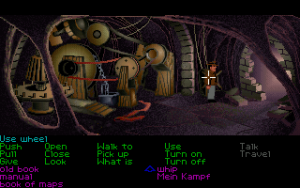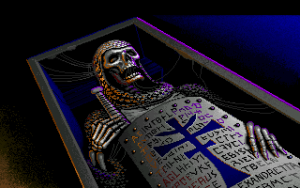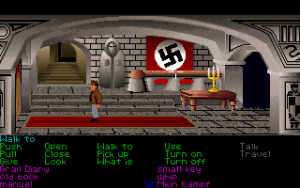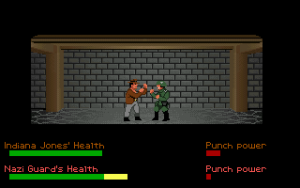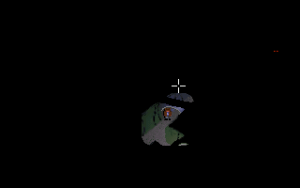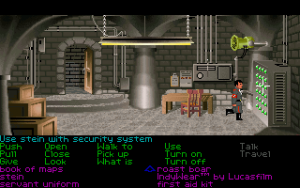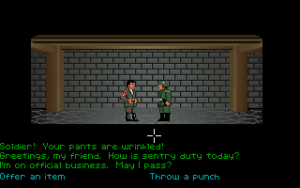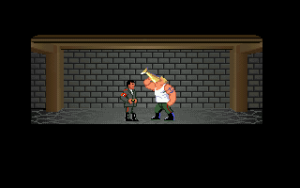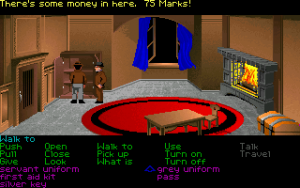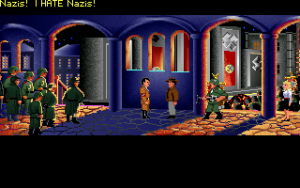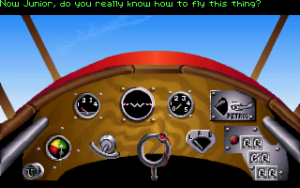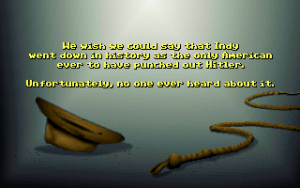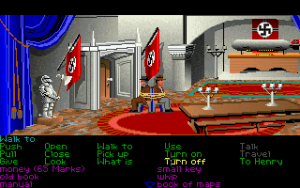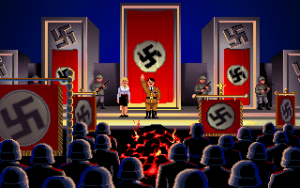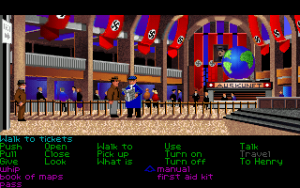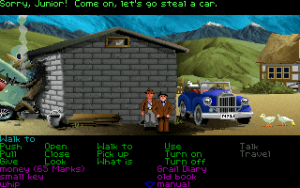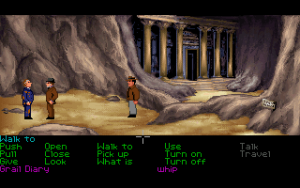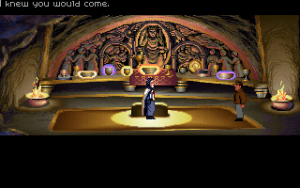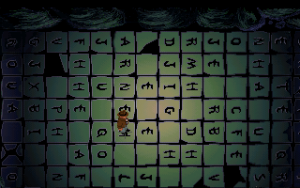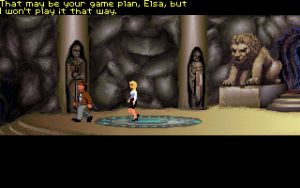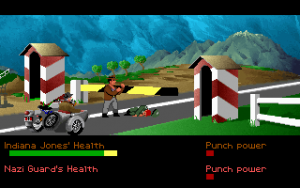- Indiana Jones and the Last Crusade: The Graphic Adventure
- Indiana Jones and the Fate of Atlantis
Indiana Jones is a name that you are required to know unless you studied abroad on Mars for the past thirty years. The franchise itself started out with the 1981 cinematic release of Raiders of the Lost Ark, a major blockbuster considered by many to be one of the greatest action films of all time. The film’s central protagonist was the handsome, charismatic, and cunning badass archaeologist, Dr. Henry Walton Jones, Jr., who adopted the moniker “Indiana” after his favorite pet dog. If you somehow don’t know by now, the main focus of Raiders is the Ark of the Covenant and Indiana’s quest to secure it before it falls into the hands of the Nazis. The depiction of Indy as delivered by the magnificent Harrison Ford, alongside fantastic production values and a brilliant supporting cast, solidified Raiders as a classic. While not quite reaching the mega-media level of Star Wars, the name of Indiana Jones ballooned into a veritable franchise.
Naturally, the success of Raiders warranted a new film, thus leading to the 1984 release of Indiana Jones and the Temple of Doom. This prequel takes place one year before the quest for the Ark, pitting Indy against the vicious Thuggee cult in a fight to secure the mystical Sankara stones. While often not revered to the level of Raiders, this sequel is generally considered a great film in its own right despite an overall darker and gorier tone, which may have alienated some fans, not to mention the presence of a certain obnoxious banshee who shall remain unnamed. In 1989, five years after Temple of Doom, Indiana Jones and the Last Crusade effectively dazzled eager audiences. Many considered it to be a finer adventure than the previous film (and some even rate it higher than the first) primarily due to the excellent interplay between Ford and the immortal Sean Connery in the role of Henry Jones, Sr.
Indiana Jones was the big thing in the eighties and remained reasonably popular throughout the nineties. Indy’s adventures within and outside of the films have been depicted through various mediums, including The Young Indiana Jones Chronicles, a television series about Indy’s earlier adventures, various novels and comic books, a role-playing tabletop game, two different adventure rides in Disneyland America and Disneyland Paris, and of course, CD releases of John Williams’ original soundtracks of all films. Indy had effectively pervaded all forms of media entertainment and remained adored by millions of fans despite some recent controversy due to the fourth and most recent film, released nineteen years after Last Crusade. Indiana Jones and the Kingdom of the Crystal Skull has been subject to a highly divided range of criticism for all sorts of reasons.
The Indiana Jones films are action and adventure tales at their core which ideally make them prime cuts for video game adaptations. Of course, many gamers who know how the industry works find that games based off of movies end up sucking for various reasons, the primary factor often being a lack of quality care on the part of the developers. The game makers often figure they can make a quick buck with whatever they churn out despite how much the actual game sucks, so the end product often turns out to be shoddy. Indiana Jones has had a relatively decent track record with virtual entertainment, but “relatively” is the key word here. The very first Indy game was released for the Atari 2600 in 1982, based on Raiders of the Lost Ark and designed by Howard Scott Warshaw. Warshaw had been responsible for the absolutely fantastic Yars’ Revenge and the fantastic trainwreck that was E.T. The Extra-Terrestrial(which is a choice example of the aforementioned curse of film-to-game translations). Depending on who you ask, it’s either a highly advanced epic that set the bar for other adventure games of the time or an outright bloody frustration that’s way more complicated than it should be.
In 1984, Indiana Jones and the Lost Kingdom was released for the Commodore 64, which was mostly a quick cash-in effort, sticking a sprite looking vaguely like Indy into a number of puzzle-oriented dilemmas. In 1985, Temple of Doomgot its own game for the arcades, developed by Atari and made as a straight-on action game where the object is to rack up as many points as possible by saving children and kicking Thuggee ass. This is a fun game that captures the feel of the film, and the soundtrack actually translates surprisingly well to the arcade synth. It also received an NES port in 1988 that changed a lot of things from the original arcade formula and became more of an adventure title, but it was muddled with a lot of stupid design choices and horrid hit detection, ultimately making it a porting disaster. A mostly-unknown text adventure based on an original adventure, Revenge of the Ancients, was released in 1987.
From here on out, most Indy titles were developed by teams working under Lucasfilm’s virtual development branch, Lucasfilm Games, or as it was soon renamed, LucasArts. LA’s first ever adventure title was a text-and-graphic combination based off of the classic ’80s fantasy flick Labyrinth. Afterward, Ron Gilbert and Aric Wilmunder devised the SCUMM gameplay engine for their adventure titles and the company made two entirely original ventures – the darkly comic horror-esque Maniac Mansion and the screwball sci-fi sojourn Zak McKracken and the Alien Mindbenders. While they were modest successes and have a strong cult following today, LucasArts had yet to establish itself as a worthy rival for Sierra, the graphic adventure monarch of the ’80s. The company would soon find larger success by tying their next adventure to Lucasfilm’s global action-adventure film series, and it could be said that this move gave it the extra edge needed to clash sabers with Sierra and give it a worthy challenge, if not surpass it in the genre.
1989 saw the theatrical release of Indiana Jones and the Last Crusade, and to promote the film, two completely different games were released; One subtitled the The Action Game and the other The Graphic Adventure. The Action Game had bad control, poor hit detection, and too much other frustrating factors, thus classifying it as your typical underdeveloped cash-in. However, by virtue of people who actually gave a damn about video games, The Graphic Adventure turned out to fantastically and stood out as one of the greatest titles representing its genre for the time. Its primary developers were Maniac Mansion co-creator Ron Gilbert, Zak McKracken programmer David Fox, and freelance programmer and frequent LucasArts collaborator Noah Falstein. Not only had it made for a fantastic adventure game, but it also stayed very true to the feel of the film.
The story is very similar to the film off of which it is based: In 1938, after a thrilling adventure concluding with the retrieval of a long sought after artifact, Doctor Jones returns to Barnett College and is overwhelmed by a mob of students who wish to see him regarding various academic matters. The good professor effectively blows off his students and exits out of a window, but he is soon accosted by a duo of taciturn men. They recruit Indy on behalf of wealthy businessman Walter Donovan, a man fascinated with the ancient Christian legend of the Holy Grail, the drinking vessel graced by Jesus Christ at the Last Supper. According to legend, whosoever drinks from this sacred chalice receives immortality. Naturally, the Nazis can abuse this to create an invincible army of deathless super soldiers and keep Der Fuhrer alive for a damn long time. Donovan presents Indy with a diary full of information about the Grail and a broken slab alluding to the Grail’s possible location; Donovan states that these items were secured from their original owner, an agent Donovan trusted to obtain the Grail but was detained by the Nazis. Donovan offers Indy a chance to pick up the job after the previous explorer was forcibly detained, and while Indy initially refuses and claims that the Grail is his father’s area of expertise, Donovan drops the bomb: Henry Jones, Sr., is the explorer currently in captivity!
If you’ve seen the film, then you know the major characters involved. Indy and his father are joined by their pal Marcus Brody, the very model of the typical absent-minded professor, as well as Elsa Schneider, a gorgeous archaeologist who initially collaborates with Indy to search for the Grail in Venice. Unfortunately, Indy’s good friend Sallah is absent from the game, and so is Kazim of the Brotherhood of the Cruciform Sword. The game follows the basic structure of the movie, but several events from the film actually play out quite differently in the game, toning down the action aspect to focus more on the adventure and omitting some film scenes entirely. Most of the puzzles have alternate solutions that greatly differ from the events of the film. Different solutions earn you “Indy Points,” which add up to an overall total of 800. The only way to obtain all 800 points is to play the game multiple times and figure out almost every different solution to each puzzle and obstacle (although there are a few actions that earn you no points despite advancing the game).
The opening pays tribute to the young Indiana sequence at the beginning of the film, as the credits are painted as art on the circus train atop which young Indy ran to evade the bandits who stole the Cross of Coronado. You do not actually play the young Indy sequence or the bit on board the ship where Indy manages to finally take back the Cross as an adult, but those events are more action-oriented and wouldn’t provide suitable substance for this game’s style. The game itself starts at Barnett College, where a thoroughly soaked Indy tells his best friend and colleague, Marcus Brody, that he finally got the Cross after all these years. After changing into his professor clothes, you are put in control of Indy and presented with the interface. There’s not too much to do at the college except advance the story or don boxing gear and fight with a trainer in the gymnasium. It is worth doing this little side task to get a feel for the game’s fighting controls.
Wait, what now? Fighting in a point-and-click adventure game?! Though action may not be the focus of this particular title, the fact that it’s based on an action film meant some of Indy’s brawling had to factor in somehow. The Last Crusade was the first adventure title ever to engage your avatar in fisticuffs with antagonistic ruffians. As you could probably guess, the fighting controls are awkward and stodgy, utilizing the numeric keypad to deliver punches, shuffle around, and block. Fighting is only necessary at a few points, and most situations that might lead to brawls often have alternate solutions allowing you to circumvent them. Aside from the fighting, the point-and-click controls are similar to Maniac Mansion and Zak McKracken, although the higher resolution allows for a much smoother looking interface. Some commands, such as “Pick Up” and “Open,” will often be required, while others are decidedly specialized and have very little use. This is before the days where right-clicking on an object automatically puts it into use, so it’s somewhat annoying to navigate with all the commands at times.
After searching through the elder Dr. Jones’ ransacked house (where it would be in your best interest to find a painting of the Grail or else be lost later), the adventuring proper begins in the city of Venice, where Indy and Brody meet up with Dr. Elsa Schneider. Most of the events should be familiar. You have to find the secret entrance into Sir Richard’s tomb beneath the library, but this time around, “X” does not always equal the spot. Every time you play the game, the exact location of the tomb entrance varies, and you have to use Jones the elder’s Grail diary to determine a certain clue that tells you of the tomb’s location. There are also a few handy books in the library that could help you for certain points later in the game, but failing to get them before leaving Venice means that they’re gone forever. None are absolutely required to beat the game, and LC is pretty good on the whole about avoiding unwinnable situations, which were present in both Maniac Mansion and Zak McKracken. That’s not to say this element is gone entirely, and there are a couple of “unwinnable situations,” as well as there being several ways for you to die. LC is an earlier LucasArts adventure, and thus, you had better save often and in different files to ensure that you don’t get stuck in any fatal predicaments.
Once you get into the catacombs, you enter an overhead perspective where you stumble through the dark underground maze. Thankfully, you aren’t wading through an oily lake swimming with rats and the impending threat of fire looming behind you, but if you didn’t grab a book in the library, navigation can be particularly tricky. Some information you find down here is likely to be confusing if you received the game without the various packaging items with which it came. As a form of copy protection, you have to refer to these faux newspaper clippings and Grail diary entries that came with the box. The information you find in the catacombs is what you use to determine the true Grail at the end of the game, and if you don’t have the proper info (which varies for each play), you’ll just have to take a lucky guess and hope you don’t choose poorly.
After Venice is Castle Brunwald, which is arguably the most frustrating part of the game. If you know what to do, it can be cleared in about fifteen minutes. However, screwing up will get you captured or killed, and you can potentially boff it up bad enough that the game becomes unwinnable. There’s a fair deal of trial-and-error throughout this section where you can elude the apprehension of the several Nazi guards wandering around the halls. You can talk your way around them, but you need to know the exact dialogue path and be wearing the right disguise (and in a couple of cases, offer a special item) to avoid fisticuffs. If you do not know what to do with a guard, then you will be forced to fight him with the awkward control scheme. You’re likely to get into several fights without an FAQ on hand, and the gimpy controls make it an ordeal enough. However, the crappy part is that you only recover a little bit of life after each fight. If you get into too many, you’re going to find fights nigh-impossible to win with your low health bar. There are a couple of medkits around the castle, but you have to use them VERY sparingly and not use them after every fight you come across, which is admittedly very tempting. As a bit of advice, do NOT squander the beer in the kitchen keg, as it is necessary to intoxicate Biff, the invincible Nazi, near the top of the castle. Also, the portrait of the Grail found at Henry’s house in the beginning is another essential piece of information required to determine the true Grail at the end.
The game becomes more lenient after Brunwald, and it gets creative with the alternative solutions to drastically change the course of events from the film. For example, if you trick Colonel Vogel by giving him a false Grail diary, you’ll skip over the Berlin scene entirely and go straight to the airport. (If you do go to Berlin, you’ll meet with Der Fuhrer himself, who was involved in one of the most hilarious moments of the film. In the game, you can opt to punch him in the face. It does not go well.) At the airport, you can steal tickets, pay directly for them if you have enough German Marks, or fight the ticket-taker (who just so happens to be the toughest opponent game, not counting Biff the Nazi). Going onto the zeppelin will eventually force you to navigate a maze on catwalks fraught with lots of vicious fights before you get to an escape plane. However, if you picked up a certain book from the library, you can opt to start up your own biplane instead of boarding the zeppelin and forgo the hassle of having to navigate around the blimp’s infrastructure. Flying the plane requires you to utilize the number pad (in a slightly less frustrating way than the fights) to dodge the Luftwaffe assault while Henry blasts the enemy planes. Depending on how many planes you destroy before you get shot down, you will have to face fewer roadblocks on the way to Alexandretta when you continue the rest of the journey by car. The guards you stop you at each roadblock act as in Brunwald; i.e., find out a way to talk or bribe your way around them, or just get to punching their faces in. A certain item can even help you skip over every single guard just by showing it to them!
Finally, you get to the climax of the adventure, the three trials that will determine whether or not you are worthy enough to possess the Holy Grail. Two of the trials simply require clicking in the right place, and if you’ve seen the film, you know how to pass the “Word of God.” It culminates in choosing the true Grail, which isn’t as simple as picking the humble cup of a carpenter. You’ll have to refer to the texts mentioned in Venice that came with the game and the special Grail painting in Brunwald to choose the correct chalice; failure here causes Indy to turn into a corpse and promptly explode, which is not at all a good thing. Screwing up at any point during the final trials boots you back to the beginning of this segment, and unless you are playing on ScummVM, you CANNOT save during this end stretch. You could just decide on the true Grail using trial and error, but this would mean having to slog through the previous trials over and over again. Once you correctly determine the true Grail (or make a lucky guess) and pick it up, you can make one final break from the events from the movie and manage to give the Grail back to the knight and even keep Elsa alive!
All in all, The Last Crusade is fairly short for an adventure game, and it can be cleared in a bit less than an hour if you’re familiar with how it works, but it offers variety and replay value with the many different solutions to its puzzles overall. The hand-to-hand combat is awkward, and some of the solutions are naturally difficult to figure out without looking up some help. That being said, Last Crusade is remarkable for being a licensed title that is entertaining and reasonably faithful to its source material. Due to its license and a design that is decidedly less frustrating than its predecessors, it was likely LucasArts’ biggest adventure hit before Secret of Monkey Island. If you are an Indy fan, and are willing to put up with some typical adventure game frustrations, then this title comes highly recommended for your inner archaeologist.
Naturally, the visuals and music vary depending on the version you play. The Last Crusade was originally made for the PC in EGA graphics format, and it looks decent aside from some garish coloring brought about by technical limitations. The Amiga and Atari ST versions have better sound quality, but at the cost of slower movement in gameplay. It’s serviceable, but the slow speed arguably makes this the worst version of them all. The Macintosh version is mostly the same but uses a high resolution font and different speech windows. It was later re-released in 256-color VGA for IBM PCs, which looks substantially better than the original. This version was also ported to the Japanese FM Towns computer. Other than some extremely minor graphical changes here and there, the only difference is the CD audio music in place of the MIDI synth used in the other versions. The Amiga version was also released on the Amiga CDTV platform in Germany, and while the graphics are the same, it also includes CD audio.
